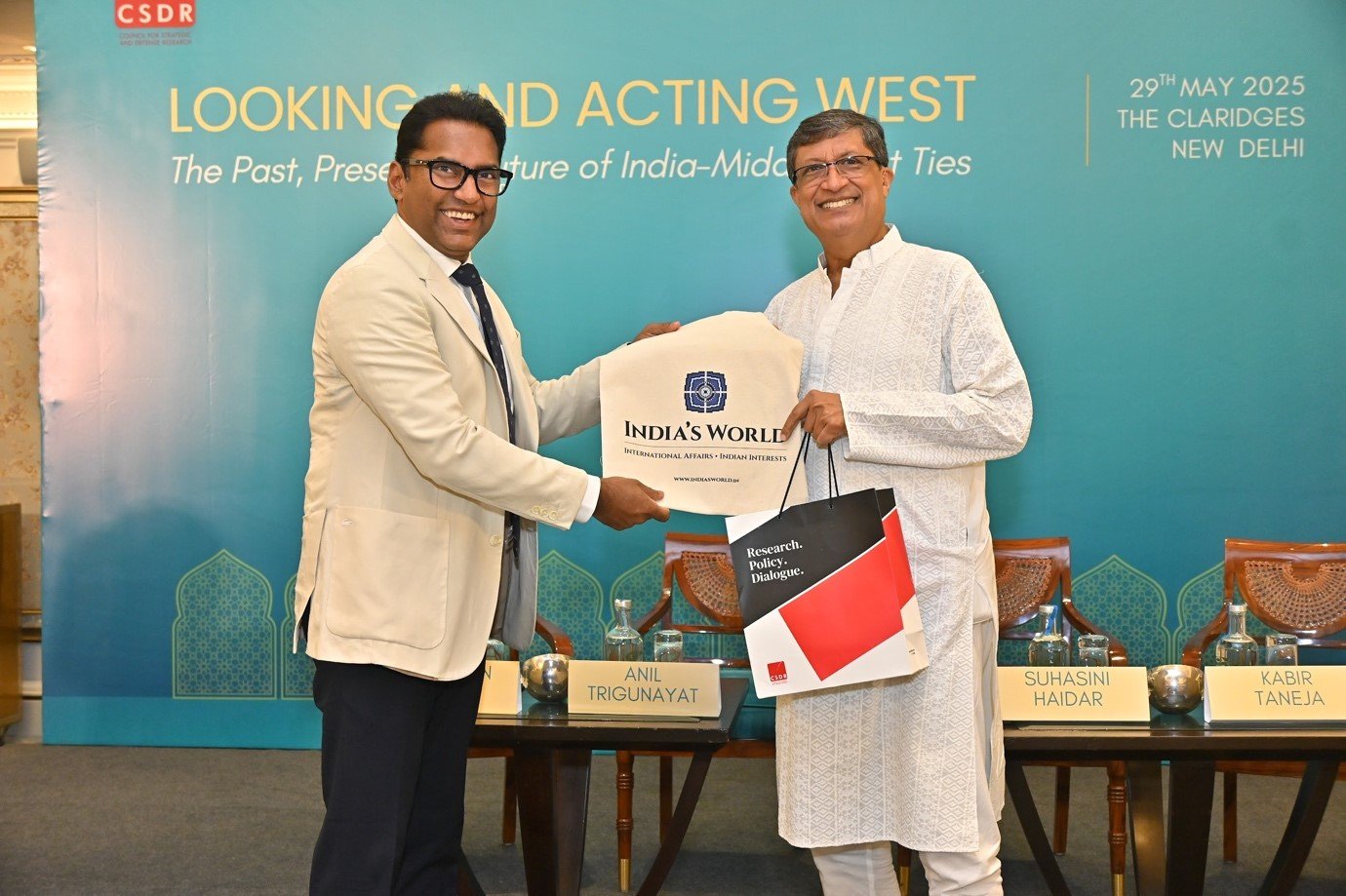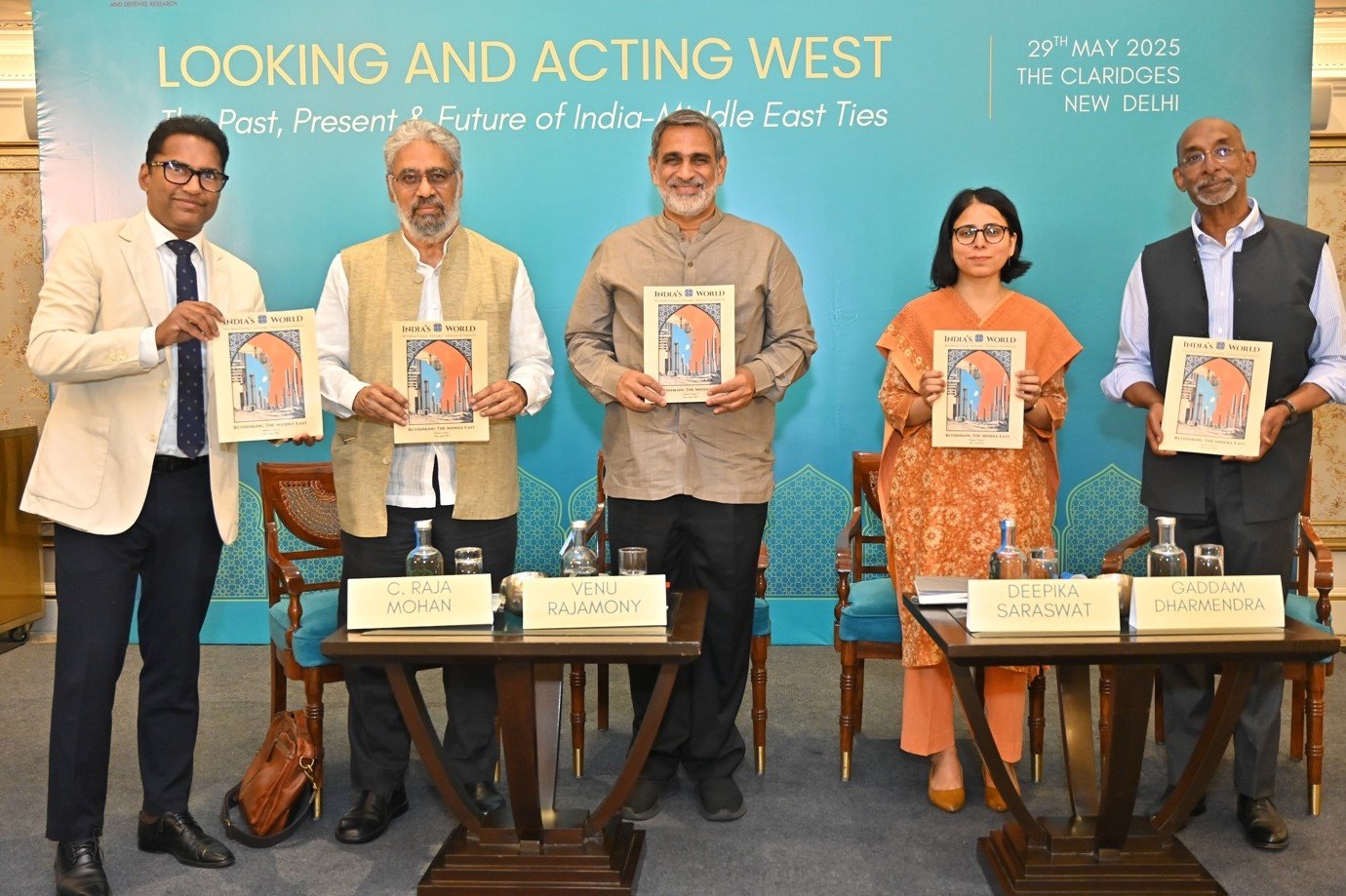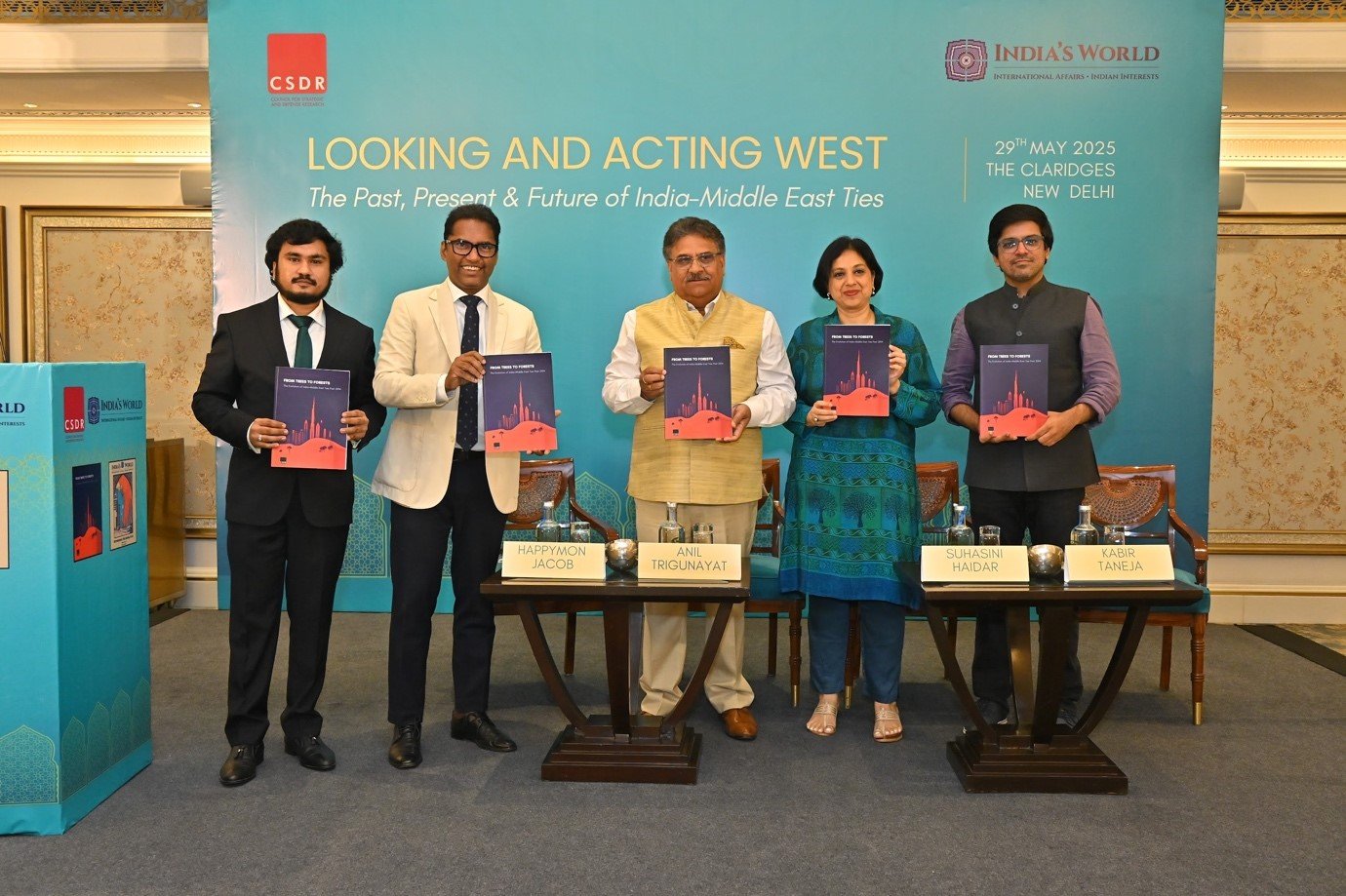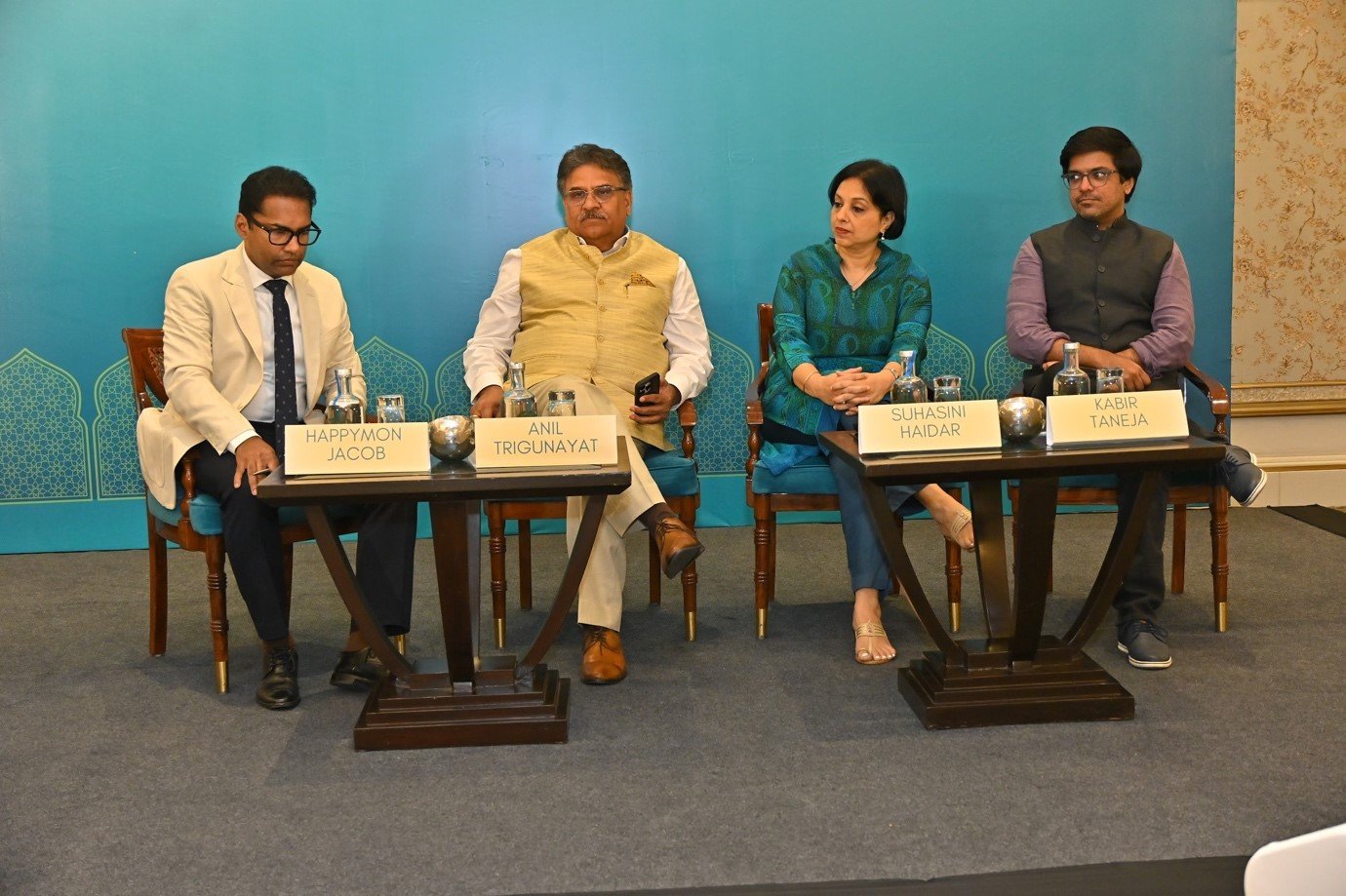India’s World and the Centre for Strategic and Defence Research (CSDR) co-hosted a day of high-level strategic dialogue at The Claridges, New Delhi, focussed on India’s deepening engagement with the Middle East. Titled “Looking and Acting West: The Past, Present & Future of India–Middle East Ties,” the event featured a keynote by Ambassador Sanjay Bhattacharyya and two power-packed panels with Dr. Happymon Jacob, Amb. Anil Trigunayat, Suhasini Haidar, Kabir Taneja and Dr. C Raja Mohan, Amb. Venu Rajamony, Amb. Gaddam Dharmendra and Dr. Deepika Saraswat. From past shifts to future strategies, the discussions offered sharp insights and reaffirmed the need for sustained cross-regional engagement.
Read the keynote speech by Ambassador Sanjay Bhattacharyya below.
Thanks for that invitation to come here and be with all of you today, and thanks for the introduction.
I was actually quite closely connected with the transition from Look East to Act East, because I was Joint-Secretary South at that point of time. I did not have as intimate a connection with the Look/Act West in terms of its policy implementation in the initial phases, but as fortune would have it, I was asked to go to Egypt, and of course I met with many people, and I think from the first few influences that I had, I would wish to recall Ambassador Salman Haidar, who was an ambassador in Beijing, and he retired, and when he heard that I was going to Egypt, he wanted to share his ideas with me.
Once I got to Egypt, I think one of the most influential voices that I came across was the Grand Sheikh of Al-Azhar, and in some ways I think a lot of what happened echoes the kind of ways that they were looking at things. This is a very knowledgeable crowd about the Middle East, so I will not get into details, because you know what those details are, but I think what might be more interesting would be to see the perspectives, because those perspectives can provide the narratives that we are looking at, and the stories of how things are happening. So what I thought was, okay, I will trace as I see the regional developments in a few short expressions, and then look at how we have been engaging with the region.
If you were to look at regional developments, I picked up three broad strands. First, the shifting sands of geopolitics. Second, the islands ahead of the curve centres in a larger sea, which is more static or slow-moving. And thirdly, the ideas of radicalism and conflict which are there in the region.
So if we look at the shifting sands of geopolitics, some time back, I do recall some of the members of the Gulf States were saying that is America withdrawing from the region? Is there a sense of anxiety about it? But I think there is a certain new kind of interest that the Americans have expressed, not least as we would have seen in the recent pivot of President Trump. If it was more transactional, economic in nature, it could be, but I think there is a renewed U.S. presence in the region.
What we do see is that the Russian presence, which was there in the wider region, has been somewhat diminished because of their preoccupations elsewhere, but they haven’t really gone away. And the country that we see that has made the most rapid advances is probably that of China. It’s not just BRI in which they are actively engaged in various aspects within the region, but I think more in terms of the technology collaborations, the defence relations that they’ve built up, and in some ways even their political initiatives in trying to work out deals between Saudis and Iranians, for instance. And so I think if you were to look at the large powers from outside, that is the broad spectrum, to put it very simply.
But what’s also important for the region of West Asia/Middle East, is what I call peripheral regions. And sometimes we tend to have a very constrictive view of the Middle East, so let’s call them peripheral powers. And I see three very significant ones, which are essentially Iran, Turkey, and Egypt, which are not strictly, you know, in our definition of West Asia, but they’re very, very key to the region. I think if you were to look at them, the most recent developments would suggest that although there was a certain ascendance of the Iranian power in terms of what they were able to do in Syria, Lebanon, and otherwise, that has diminished according to what we’ve seen in the last several months. But they are still a major factor in terms of what they have in terms of influence all around.
The Egyptian power, and I go back to the influence of their kind of Islam, and I’ll talk a little bit about that later, is still not that deeply felt, although the presence of Egypt from the Arab League is a very, very visible factor in that region. The power of Turkey, in contrast, has expanded very significantly, and Turkey’s influence in the region has kind of seen in terms of not only its ability to influence governments or the changes of regimes we saw most recently in Syria, of course, but in terms of the overall decision to be engaged, and their very broad-based engagement in terms of their political content, their military endeavours, the outreach of their culture, and the rapprochement that has happened with the Arab States. You know, today, Turkey is much more closely engaged with the Gulf States’ diplomacy, economic engagement, and so Turkey is very much more of a presence.
But within this shifting geopolitics, the other big thing is that the countries of the region, the rising powers within the region, have actually grown in terms of content and their aspirations. So whether it is, you know, I mean, we’re not going back to the time when we’re talking about, say, Kuwait or Qatar, but today, for instance, if you look at the kind of abilities that the Saudis or the Emiratis have within the region, that is quite considerable, and their forward-looking, their future-orientated approach provides that particular construct. And, of course, there is this very dominant other partner in that region, which is Israel.
And a lot of the alliances that were coming about in that part of the world were designed towards reaping the benefits of a technological economic combination with Israel. But that, of course, received a setback. So I think there are two questions that I have regarding the geopolitics of that region.
One is, shall we have a new kind of understanding between the Gulf States and Israel? Because in some ways, that would determine the kind of progress that many of these Gulf States will have towards a future-orientated, economic, technology-based advancement. And the second one is that will this divide between the Saudis and the Iranians be bridged or continue to be bridged? Will that particular understanding hold? And that is still something that we’ll have to wait and see.
The region, as I said, has a few centres. I call them islands, which are ahead of the curve, while it is still in a sea of relative immobility or not moving fast enough. The lack of homogeneity in the region. And what that does mean is that while the age of transformation, the era of transformation, has come about, and I think if you look at the youth in each of these countries, you know, we sometimes call it loosely as Arab Street or others, you see that those sets of aspirations are already embedded in the societies of these countries.
But there is still a certain kind of disconnect because of the kind of economic, scientific orientation that many of the governments have, the kind of ability to engage and mobilise the people in activities that are directed towards their economic development, and also the kind of patterns that they have regarding leadership and the transitions of leadership, so leadership management, so to say. And so the change in most of these parts have been slow. So in the large sea, the change is still slow, but there are these pockets of excellence.
And, you know, these pockets of excellence are not just some of the Emirates or, you know, some of the GCC countries, but you find that, you know, it’s kind of beginning to spread out. And as to what kind of effect it’ll have will be very significant, because the manner in which they will engage not only amongst themselves, but with us and the rest of the world will be much more dynamic.
The third one, which is more of a stagnant story, is the continuance or the persistence of radicalism. And the fact that radicalism, extremism, is not easily challenged in that region. In other words, there is, I understand, the possibility of calling these heretical radical ideas as apostate, but it does not quite happen. And so they actually have a quest for territory.
And so recently what we did see, for instance, in Syria, was a terrorist group actually assuming control. And of course, now it is assuming the trappings of legitimacy and of State, but it is essentially a terrorist group which has taken over. And that kind of idea, which has been there in other parts earlier, has not completely died out.
And that is something that we need to be very, very careful about, because these ideas will always look for setting up bases or seeking their territory or their capitals. And if they don’t find it within the region, there is always effect outside. And we’ve seen how the combination of these radical extremist ideas sometimes also combine with elements of the Muslim Brotherhood, and there are other instruments through which this happens. So the signs of instability continue in that particular aspect.
So having given that very broad overview or brush of how I see some of the developments in the region, let me now come to how we have worked out and played with this region. As you know, of course, our relations with this region go back to millennia. Our contacts go back to, you know…when I was in Turkey, I went down to a place which is just off Aleppo. And, you know, that’s where a lot of the people originally came from. And, you know, you have the Aleppo Jews, you have the Aleppo Christians, and then the Muslims from that area, and of course from the wider region as well.
So while our contacts have been very old, they were really refashioned in modern times. And I think, again, let me put three broad developments that happened in the last 10 years or so.
The first was having this idea of an extended neighbourhood. And when we talk of an area or a part of the world as our extended neighbourhood, although it is not strictly contiguous in terms of our land boundaries, but in terms of our cultural affinities, in terms of our connectivity, what that means is that we do have that ability to have much more frequent and much more intimate contacts. And that is what we saw. The frequency and intimacy of contact with the Middle East, as you describe it, became much more over the last decade and more.
And that allowed us to look at a pattern in which we could integrate our development parts into each other. So not just to say that, you know, I have my development thing, you want to put in some investment. No, you are invested in the development priorities of that other region, and they are invested in your development priorities.
And I think what it also did when you had these very intimate relations, and I think Happymon referred to these binaries, is that you were able to set up more independent partnerships, which were devoid of what you might think somebody else might think about. I mean, would you have to look over the shoulder and say, oh, that other partner might think otherwise? No, you can actually develop relations that are far more independent and proactive.
And one of the things that happened because of that was this earlier notion that Pakistan is a big factor in the Middle East kind of eroded over that time because of the kind of engagement that we were able to have with these countries.
The second thing that we did was we always had these exchanges, and there were these two very strong pillars of our relations. The first was energy, of course. You know, we would buy a lot of oil from them. And the second was labour, because we would supply manpower. And I think to switch these relations from those of mere exchanges or trade to that in which they become an element of security, in other words, energy is not just buying and selling of oil, but it’s actually the overall context of energy security.
So are you invested in the channels up and down the value chain? Are you engaged in setting up refineries in each other’s places? Are you engaged in setting up strategic reserves in some of them?
And all of this actually happened. So, you know, that particular transition was what happened after we kind of got into this understanding that this is part of our extended neighbourhood.
It happened not just in energy. So the labour issue became more of a manpower security, and we would then go up the value chain again over here. So for instance, it wasn’t just low-skilled workers, but highly skilled professionals, management people, and how the two complemented. And that then enabled us to look at these other aspects.
So it wasn’t just that we were selling food items to the Gulf region, but they were in a sense linked with some of our priorities regarding, say for instance, the requirement of fertilisers and how we would source. So, the food security became a larger question in which we were able to engage in a much more involved manner. This also happened in health, for instance, not just doctors and hospitals, but setting up partnerships for the research and development of medicines, setting up pharmaceutical plants, hubs that were being set up.
And so I think this was a significant upgrade in the relationship that we experienced with this concept of extended neighbourhood, going into making everything, most of our relations and exchanges, into something that is a security element. And we look at it from that broader perspective. And that also sets up this duality of interest.
And when that came about, we came to the third stage of our relations with the region, which is where we are today, which is with most of our partners – we have what we call strategic partnerships. And when we have strategic partnerships, we are not only engaged in the areas and sectors that we were engaged in the past, but we are really looking at what the future holds for us and what is it that our vision for the future is.
And that meant that we would look at the dynamics of how we create a knowledge economy and how, you know, the setting up of IITs, for instance, or the setting up of trusts that actually exchange ideas between the people, of having, say, for instance, interfaith dialogue between the people, how those are then going to be leveraged. The second part of it was obviously in the digital space and given the way dynamics of the data world have evolved, that became a major pillar. Of course, IMEC was one of the key issues in that, and that brought the other aspect of connectivity.
And today, for instance, the kind of connectivity that we have with the Gulf region is unbelievable. You know, the number of flights that you have on a weekly basis, but it’s still understood and recognised that the kind of, say, shipping connectivity that we could have between the two sides could be significantly better.
And I think that’s why this IMEC idea was coming up, which would not just be an idea for the flow of connectivity of idea, data, but also of, you know, looking into the future of how we would be able to link it up.
What we also were able to do in this third phase was to link it up in terms of expanding beyond the region. In other words, can India and the Middle East look at projects in third countries, third-partner countries? And as that grew, so whether we are doing it in Africa and parts of the Indian Ocean, as that grew, the idea of connectivity or linking it up with the Indo-Pacific started happening.
And the kind of initiatives that you have from some of the countries in the Middle East about that came about. I think another very future-orientated idea that came about was I2U2, which really takes it into the next level of collaboration and various ideas, sharing of information and ideas, and taking decisions on what the future holds. Because if we don’t invest today in what’s going to happen tomorrow, we will probably miss out the bus for the future.
IMEC, in one way, I would say that it is a great idea, but it has had a somewhat limited progress in terms of its implementation, because of the conditions of conflict over there, which we talked about earlier. And unless we can take care of that, I think some of these projects would have faced setbacks.
So that, I think, is the path in which we went ahead from one in which we had this concept of extended to securitisation to strategic partnerships looking at the future.
So if I want to kind of sum it up in just a few words as to where we are, I would say I think we are in a good spot. I would still not say it’s a sweet spot, because I think there are complementarities in our relations which need to be developed still further.
I think we have some competition, because the kind of role that some of the other countries have in the region has also been expanding, perhaps at a faster pace. But we do have the ability and we have the receptivity on both sides to be adaptable and to move towards smart decision making. So I think at the end of the day, that transition from being in a good spot to a sweet spot is something that could actually be realised, and I am positive and optimistic about that.
Thank you very much.







